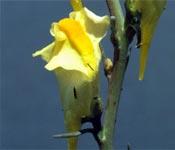Other Names – Butter-and-eggs, wild snapdragon
Family – Snapdragon Scrophulariaceae
Life Cycle – creeping perennial
Habitat – conventional tillage, reduced tillage, forage crops, hay fields, rangeland, turf, roadsides, waste areas
Key Features
- Found in patches due to creeping roots
- Crowded, linear leaves that are narrower at each end
- Bright yellow and orange flowers that are “snapdragon-like”
Seedling
Yellow toadflax cotyledons are round with a very prominent rounded bump at the top. The first few true leaves are oval. Subsequent leaves are narrower and linear. This species is becoming more prevalent in reduced tillage systems.
Juvenile
Yellow toadflax spreads by extensive creeping roots that form dense patches. The stems are erect, hairless and branched above. The leaves are alternate, although often crowded on the stem. The linear leaves are narrowed at both ends. This feature helps to distinguish it from Dalmatian toadflax, which has lanceolate to broadly ovate leaves that clasp the stem. Before flowering, yellow toadflax can be distinguished from leafy spurge by breaking the stem. Leafy spurge has a white milky latex inside while yellow toadflax does not. Yellow toadflax contains some toxic compounds but is usually avoided by grazing livestock.
Mature
Bright yellow flowers with orange centres are grouped into racemes at the ends of the stems and branches. Each flower is “snapdragon-like” with an upper lip and a lower lip that has a conspicuous protrusion or “spur” extending downwards. Each flower develops into a seed capsule that releases many dark brown to black seeds. Each seed is flattened with a circular wing on the margin for wind distribution.
 |
 |
 |
